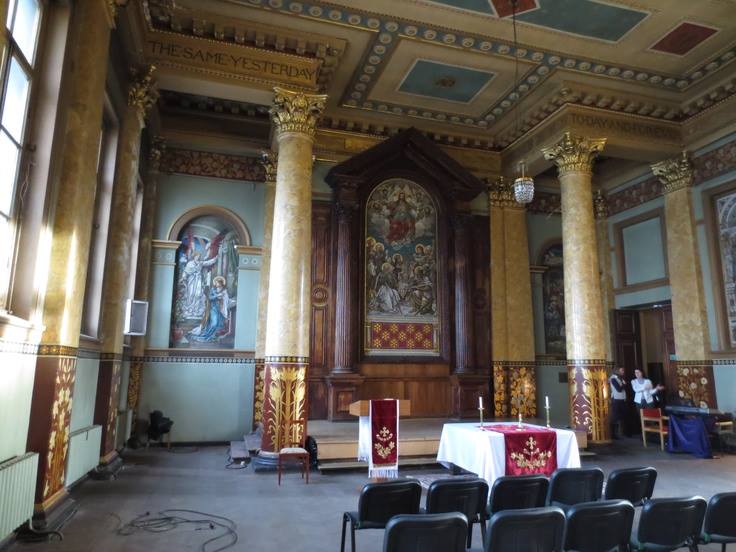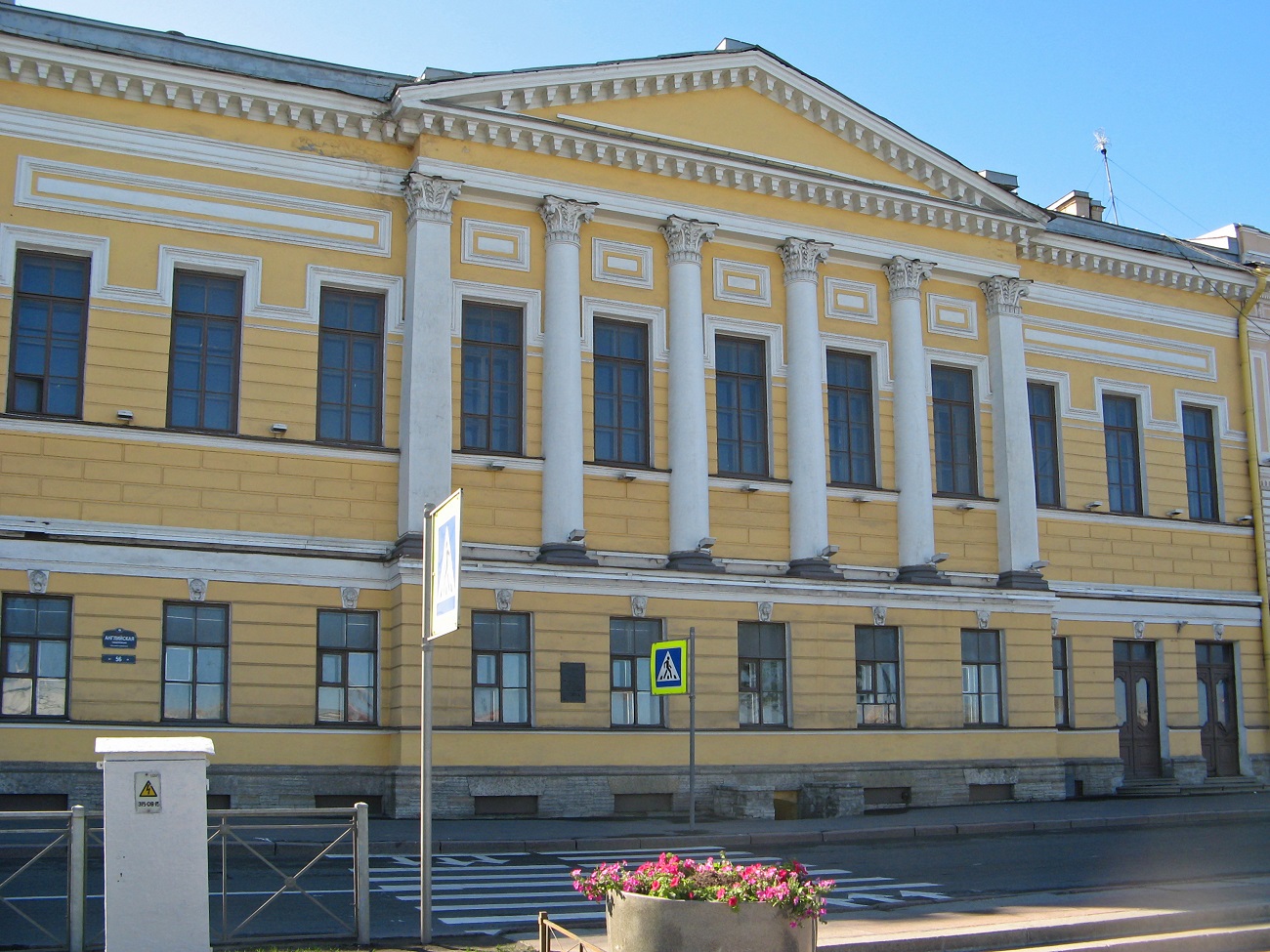
Historical building of the Anglican Church in St. Petersburg.
Press photoThe first Church of England congregation in St. Petersburg was established during the time of Peter the Great. After the Bolshevik Revolution, the church’s priests fled Russia and Anglican services were resumed only in 1993. RBTH spoke to Adrian Terris, who has been the churchwarden of the Anglican Church in St. Petersburg, since 1998 about its past and present.
RBTH: Adrian, what did bring you to Russia and St. Petersburg?
Adrian Terris: I first came to St. Petersburg in 1994, fired by a love of Dostoevsky and a curiosity to understand the Russian soul, and have remained involved with Russia ever since.
Having started as a churchwarden at the Anglican Church in St. Petersburg in 1998 (and having served, at different times, three terms or roughly 15 years as warden since then), I have helped with the running of the church more or less ever since.
 Adrian Terris poses for a photo near the Winter Palace in St. Petersburg. Source: Personal archive
Adrian Terris poses for a photo near the Winter Palace in St. Petersburg. Source: Personal archive
RBTH: What are main differences between the Russia you saw when you first arrived and Russia now in terms of religion?
A.T.: While many churches and cathedrals were still standing in 1994, very few remained as places of worship with the others serving as youth and sports clubs, offices, warehouses etc. Now the churches had been restored and rebuilt, and over 80 percent of Russians identify as Orthodox, up from 30 percent in the early 1990s.
RBTH: What were the main places of worship for the English community at the beginning?
A.T.: Separate Anglican worship in St. Petersburg began in 1723, when the English mercantile traders of the Russia Company were relocated to the northern capital by decree of the Tsar Peter the Great, and brought their chaplain with them. They held their services in the house at 56 English Embankment, which was rented out to them by the nobleman Peter Sheremetyev. [Ed.The Anglican Church of St. Mary and All Saints was built at this address).
 56 English Embankement. Source: Ekaterina Borisova / wikipedia.org
56 English Embankement. Source: Ekaterina Borisova / wikipedia.org
Trade between Imperial Russia and Britain fueled and funded the development of the Anglican church locally, which was primarily aimed at supporting the British community and the British crews of visiting ships, including, from 1822-1902, running a church and seaman's hospital in Kronstadt [ed. A port city 19 miles outside St. Petersburg] as well as operating a seaman's chapel in Arkhangelsk during the summer shipping season.
By the early 1900s, the church had three priests, an electoral roll of 2,500, and regularly held services at textile manufacturing outposts with sizeable British workforces.
RBTH: The main church of the Anglican congregation was closed during Soviet times. Are you able to hold services there today?
A.T.: The Anglican Church of St. Mary and All Saints (also known more simply as the English or British Factory church) was located at 56 English Embankment and operated until 1919. The building is still standing, and has a very classical facade, not typical of a church building, but reflecting the location, the combined usage of the site for the church and for trade.
After 1919, the church was used as a library and then more recently was the home of the official City Tourist Bureau (the local offshoot of Intourist), but it did not suffer any major rebuilding or damage to its fine Victorian interior. In recent years, the State Music Conservatory leased the building, and the Anglican Church had access several times per year for major services such as Easter, Christmas and Remembrance Sunday [ed. The Sunday closest to Armistice Day, Nov. 11. That lease has now passed to the St. Petersburg Music Hall, and in the future we hope to acquire the building under Russian legislation that provides for foreign church property to be given back to the church congregation.
RBTH: What did happen to Anglican priests after the Bolshevik revolution in 1917?
A.T.: In 1918, the last chaplain of the English Church, Rev. Bousfield Saw Lombard, was arrested, thrown into a cell in the Peter and Paul Fortress and sentenced to death. His sentence was later commuted and, after six weeks, he was released and allowed to return to England. Other members of the clergy from both St. Petersburg and Moscow headed north into the newly independent territory of Finland.
From the early 1970s onwards, the Helsinki chaplain, Canon Eric Staples, who also had responsibility for the Soviet Union and Mongolia, regularly visited Leningrad on his way to or from Moscow. His papers are now held in the London Metropolitan Archives and make interesting reading, particularly the correspondence relating to the proposed marriage in Leningrad between 'some sort of poet,' a certain Joseph Brodsky, and a U.S. citizen. An application for marriage form was signed by them in April 1972 and there was some discussion relating to Canon Staples visiting Leningrad for a service once the local registration had been achieved, but this did not take place, as Joseph Brodsky obtained an exit visa for Israel instead and consequently dropped his marriage plans.RBTH: When were regular services resumed in St. Petersburg?
A.T.: The first Communion service in the new St Petersburg was held in November 1993. Thereafter, the church met on a monthly basis for house meetings, before moving to a more regular Sunday service at the turn of the millennium. The church now meets every week at 11am in the upstairs (1st floor) worship hall of the Swedish Church at 1/3 Malaya Konyushennaya ul, followed by refreshments and fellowship. Services are led by the churchwarden or by visiting locum priests. We are working towards getting permanent priest nowadays.
The church is no longer the Anglo-American expat congregation of old, but is a family-friendly mix of younger expats and exchange students, Russians, and Indonesian and African students.
All rights reserved by Rossiyskaya Gazeta.
Subscribe
to our newsletter!
Get the week's best stories straight to your inbox